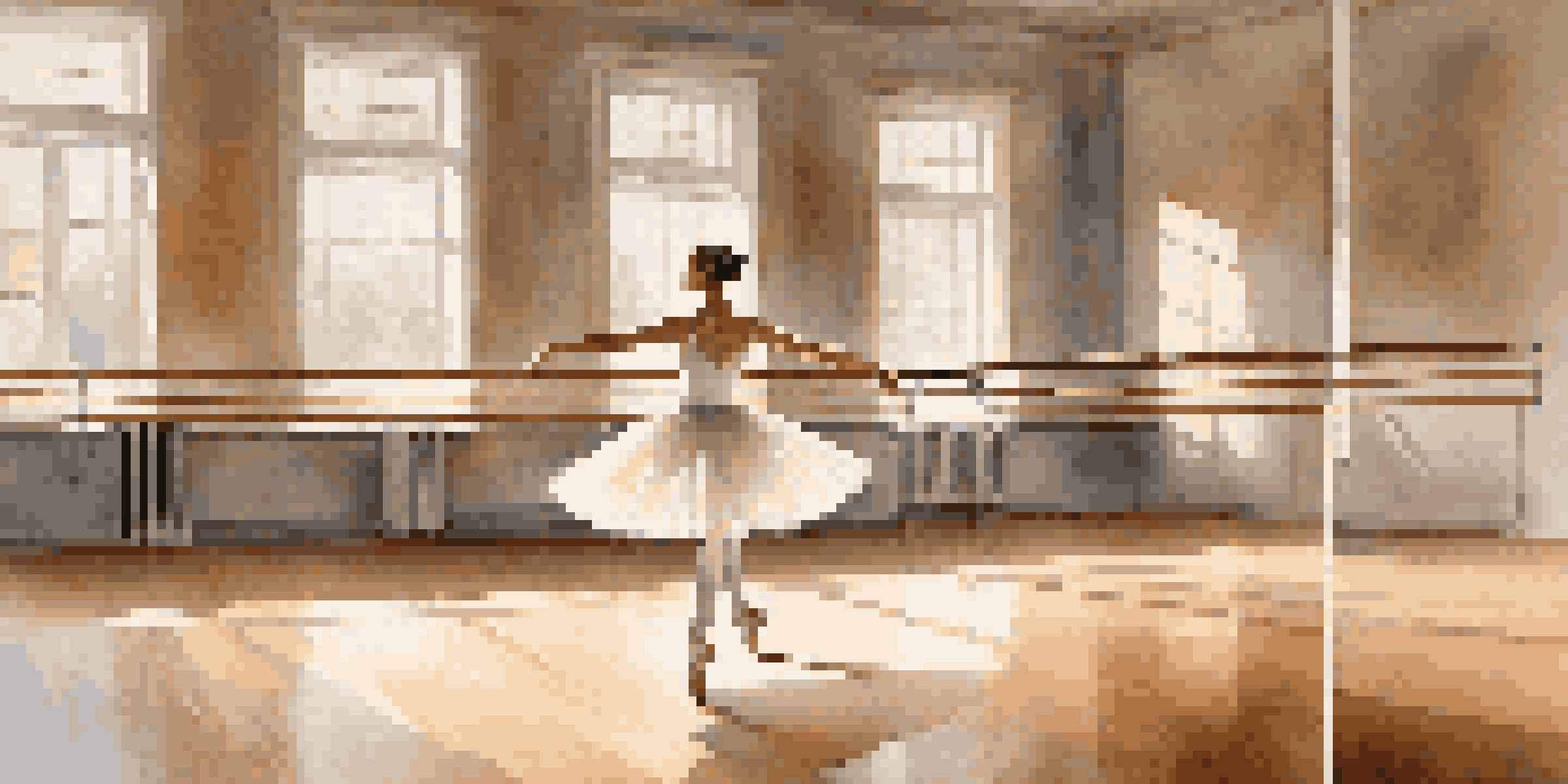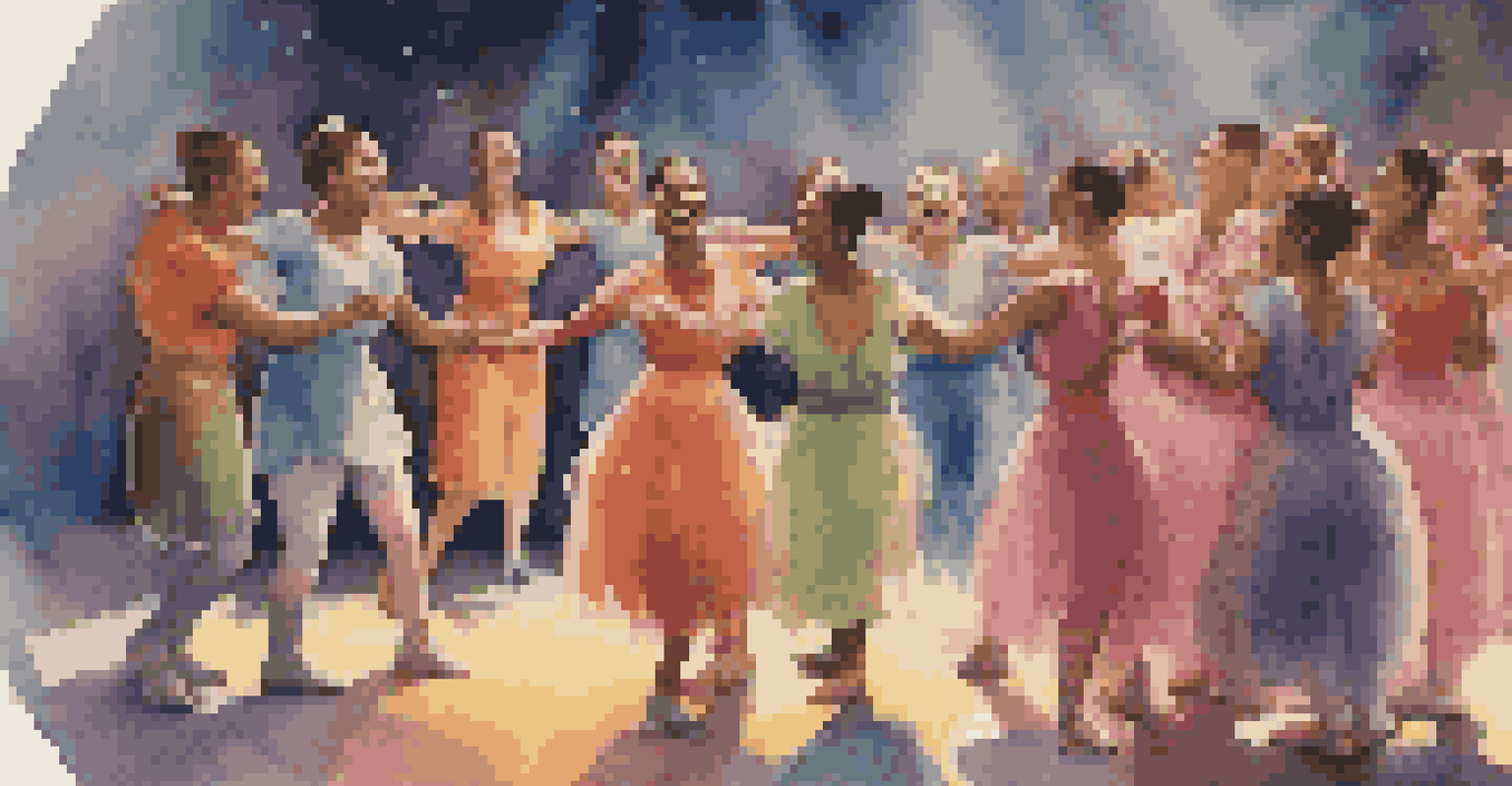Building a Positive Mindset to Combat Dance Anxiety

Understanding Dance Anxiety and Its Impact
Dance anxiety is a common experience for many performers, often manifesting as nervousness or fear before a performance. It can stem from various factors, including fear of judgment, perfectionism, or previous negative experiences. Acknowledging that you're not alone can be a comfort, as even seasoned dancers face similar feelings.
Dance is the hidden language of the soul.
Recognizing how anxiety affects you personally is vital. It can lead to physical symptoms like sweaty palms or racing hearts, which can hinder your performance. Understanding these symptoms helps in addressing them effectively, allowing you to focus more on your dance rather than on the anxiety itself.
By identifying your feelings and understanding their triggers, you can start to take control of your responses. This self-awareness is the first step in building a positive mindset. Remember, it's okay to feel anxious; the key is learning how to manage it.
The Role of Positive Thinking in Dance
Positive thinking isn't just a buzzword; it's a powerful tool that can transform your dance experience. When you replace negative thoughts with positive affirmations, it can drastically change your outlook. Instead of thinking, 'I will mess up,' try telling yourself, 'I am prepared and ready to shine.'

Engaging in positive self-talk helps to boost your confidence and reduce anxiety. Consider creating a list of affirmations that resonate with you and repeat them daily. This practice reinforces a positive mindset and cultivates a sense of self-belief, making it easier to face performances with courage.
Managing Dance Anxiety Effectively
Understanding and addressing personal anxiety symptoms can help dancers focus on their performance rather than their fears.
Remember, the brain is a remarkable tool that can be trained. The more you practice positive thinking, the more natural it will become. Over time, you'll find that a positive mindset not only combats anxiety but also enhances your overall performance.
Visualization Techniques for Success
Visualization is a powerful technique that many successful performers use to combat anxiety. By mentally rehearsing your performance, you can create a sense of familiarity and comfort. Imagine yourself dancing gracefully on stage, feeling confident and in control; this mental imagery can be incredibly empowering.
Mistakes are the portals of discovery.
To practice visualization, find a quiet space where you can close your eyes and picture yourself dancing. Focus on every detail—the music, the movements, and the applause. This exercise allows you to build a mental 'muscle memory,' which can ease anxiety when it's time to perform.
Incorporating visualization into your routine can be a game-changer. It not only prepares you for the stage but also helps to build a positive association with performing. The more you visualize success, the more likely you are to experience it.
Breathing Techniques to Calm Your Nerves
Breathing techniques are simple yet effective tools for managing anxiety before a dance. Deep, controlled breathing can help calm your nervous system and center your focus. Try the 4-7-8 technique: inhale for four seconds, hold for seven, and exhale for eight. This practice can significantly reduce stress levels.
Incorporating breathing exercises into your pre-performance routine can make a noticeable difference. Take a few moments to breathe deeply before stepping on stage, giving your body the chance to relax. This can help you shift your focus from anxiety to performance, allowing you to express yourself more freely.
Positive Thinking Boosts Confidence
Replacing negative thoughts with positive affirmations can transform a dancer's mindset, leading to enhanced performance and reduced anxiety.
Remember, the way you breathe can influence how you feel. Practicing these techniques regularly not only prepares you for performances but also enhances your overall well-being. It's a simple yet powerful way to foster a positive mindset.
Setting Realistic Goals for Your Dance Journey
Setting realistic goals is essential for building a positive mindset. While ambition is important, setting unattainable expectations can lead to disappointment and increased anxiety. Instead, focus on small, achievable milestones that celebrate your progress along the way.
For example, if your goal is to perform a solo, break it down into smaller steps—like mastering specific moves or gaining confidence in front of an audience. Each accomplished step builds your self-esteem, reinforcing a positive mindset and reducing anxiety.
By celebrating these small victories, you create a sense of accomplishment that fuels your passion for dance. Remember, every dancer's journey is unique, and embracing your individual path can help alleviate the pressure and anxiety often associated with performance.
The Importance of Supportive Relationships
Surrounding yourself with supportive friends, family, and fellow dancers is crucial in combating dance anxiety. Having a solid support system can provide encouragement and reassurance, helping you feel less isolated in your feelings. When you share your experiences, you often find that others can relate and offer valuable insights.
Consider joining a dance group or community where you can connect with others who understand your journey. This camaraderie can foster a sense of belonging and reduce feelings of anxiety by creating a safe space to share challenges and successes alike.
Support Systems Alleviate Pressure
Building supportive relationships with peers and mentors provides encouragement and reassurance, helping to navigate the challenges of dance.
Remember, you don’t have to face your fears alone. Building relationships with those who uplift you can make a world of difference in maintaining a positive mindset. Together, you can navigate the ups and downs of the dance world.
Embracing Mistakes as Learning Opportunities
Mistakes are an inevitable part of any performance, and embracing them can significantly reduce anxiety. Instead of fearing errors, try to view them as opportunities for growth. Each slip-up offers valuable lessons that can enhance your skills and confidence moving forward.
For instance, if you trip during a performance, use it as a learning moment rather than a reason to feel defeated. Reflect on what happened and how you can improve for next time. This shift in perspective not only eases anxiety but also fosters resilience.

By accepting that mistakes are part of your dance journey, you can cultivate a more forgiving and positive mindset. This acceptance allows you to focus on your passion for dance rather than the fear of imperfection.